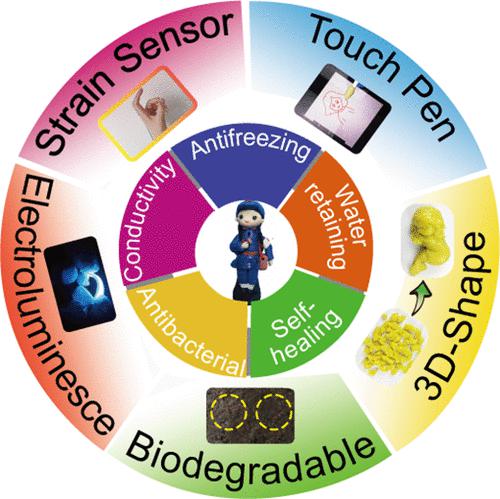当前位置:
X-MOL 学术
›
Chem. Mater.
›
论文详情
Our official English website, www.x-mol.net, welcomes your
feedback! (Note: you will need to create a separate account there.)
Engineering Ionic Dough with a Deep Eutectic Solvent: From a Traditional Dough Figurine to Flexible Electronics
Chemistry of Materials ( IF 7.2 ) Pub Date : 2023-09-07 , DOI: 10.1021/acs.chemmater.3c01761 Nan Li 1, 2 , Liyuan Qiu 1 , Xingxiang Ji 2 , Wei Chen 1, 2
Chemistry of Materials ( IF 7.2 ) Pub Date : 2023-09-07 , DOI: 10.1021/acs.chemmater.3c01761 Nan Li 1, 2 , Liyuan Qiu 1 , Xingxiang Ji 2 , Wei Chen 1, 2
Affiliation

|
Conductive ionogels had demonstrated significant prospects in the field of flexible electronics. Nonetheless, it remains a big challenge to develop ionogels, by using degradable and recyclable components, with multiple functional properties. Herein, inspired by a traditional dough figurine, a novel type of ionic dough assembled from flour, water, and choline chloride/glycerol deep eutectic solvent was engineered to replace non-recyclable and non-degradable components of present ionogels. The obtained ionic dough exhibited superior conductive performance (conductivity of 3.7 mS·cm–1), long-lasting moisture retention (80% weight retention after 24 days), reliable self-healing ability (the healing efficiency was up to 95%), and excellent antibacterial and biodegradable (entirely degraded within 30 days) properties. Wearable strain sensors based on the ionic dough can accurately detect both large and subtle human activities with high strain sensitivity (gauge factor = 6.2) and durable stability under a wide working temperature range (−20 to 80 °C). Notably, the ionic dough can be further applied in green batteries and luminescent display screens of electroluminescent devices. Therefore, it was envisioned that the effective and innovative design strategy for fabricating conductive ionogels, using natural flour components, with multiple functionalities would provide wide applications of flexible wearable devices.
中文翻译:

使用深层共晶溶剂工程离子面团:从传统的面团雕像到柔性电子产品
导电离子凝胶在柔性电子领域显示出巨大的前景。尽管如此,通过使用可降解和可回收的成分来开发具有多种功能特性的离子凝胶仍然是一个巨大的挑战。在此,受传统面团雕像的启发,设计了一种由面粉、水和氯化胆碱/甘油低共熔溶剂组装而成的新型离子面团,以取代现有离子凝胶的不可回收和不可降解的成分。所得离子面团表现出优异的导电性能(电导率为3.7 mS·cm –1)、持久保湿(24天后保重80%)、可靠的自愈能力(愈合效率高达95%)、优异的抗菌和生物降解(30天内完全降解)特性。基于离子面团的可穿戴应变传感器可以准确检测大型和细微的人类活动,具有高应变灵敏度(应变系数 = 6.2)和在宽工作温度范围(−20 至 80 °C)下的持久稳定性。值得注意的是,该离子面团还可进一步应用于绿色电池和电致发光器件的发光显示屏中。因此,可以预见的是,使用天然面粉成分制造具有多种功能的导电离子凝胶的有效和创新的设计策略将为柔性可穿戴设备提供广泛的应用。
更新日期:2023-09-07
中文翻译:

使用深层共晶溶剂工程离子面团:从传统的面团雕像到柔性电子产品
导电离子凝胶在柔性电子领域显示出巨大的前景。尽管如此,通过使用可降解和可回收的成分来开发具有多种功能特性的离子凝胶仍然是一个巨大的挑战。在此,受传统面团雕像的启发,设计了一种由面粉、水和氯化胆碱/甘油低共熔溶剂组装而成的新型离子面团,以取代现有离子凝胶的不可回收和不可降解的成分。所得离子面团表现出优异的导电性能(电导率为3.7 mS·cm –1)、持久保湿(24天后保重80%)、可靠的自愈能力(愈合效率高达95%)、优异的抗菌和生物降解(30天内完全降解)特性。基于离子面团的可穿戴应变传感器可以准确检测大型和细微的人类活动,具有高应变灵敏度(应变系数 = 6.2)和在宽工作温度范围(−20 至 80 °C)下的持久稳定性。值得注意的是,该离子面团还可进一步应用于绿色电池和电致发光器件的发光显示屏中。因此,可以预见的是,使用天然面粉成分制造具有多种功能的导电离子凝胶的有效和创新的设计策略将为柔性可穿戴设备提供广泛的应用。


















































 京公网安备 11010802027423号
京公网安备 11010802027423号